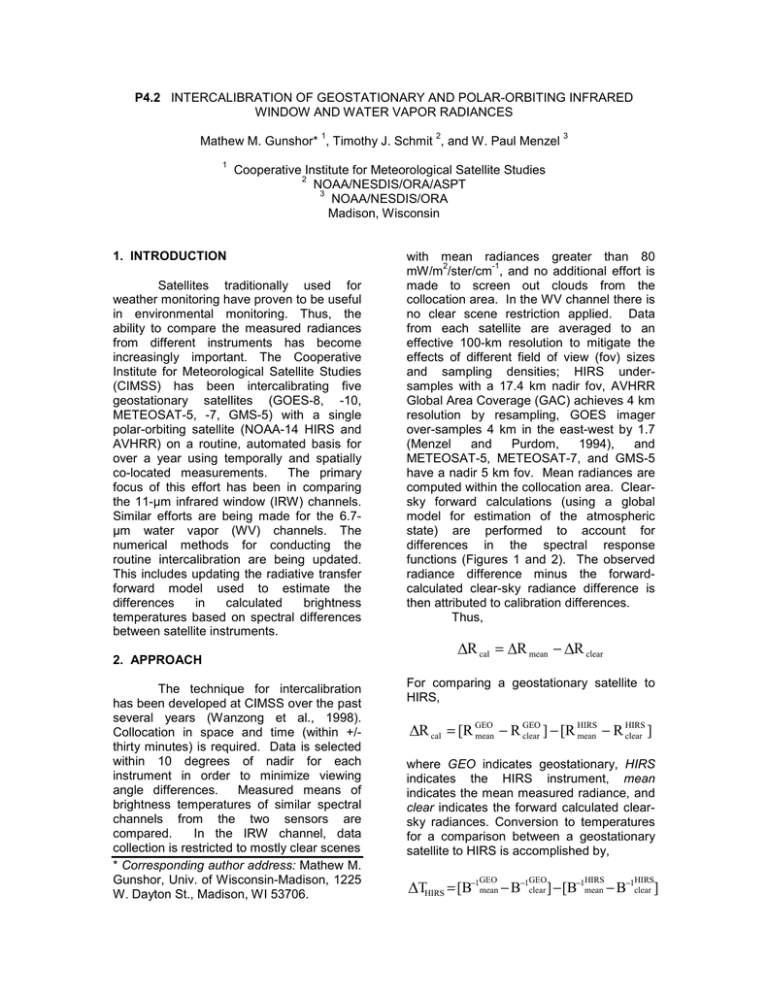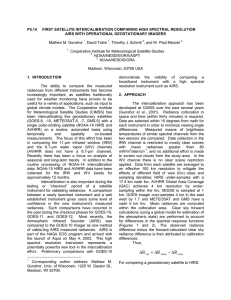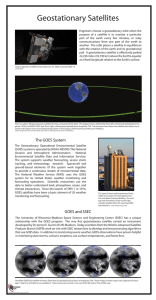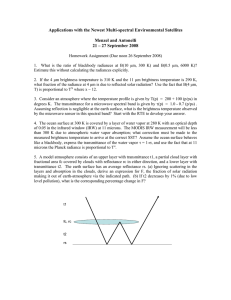P4.2 WINDOW AND WATER VAPOR RADIANCES Mathew M. Gunshor* , Timothy J. Schmit
advertisement

P4.2 INTERCALIBRATION OF GEOSTATIONARY AND POLAR-ORBITING INFRARED WINDOW AND WATER VAPOR RADIANCES 1 2 Mathew M. Gunshor* , Timothy J. Schmit , and W. Paul Menzel 1 3 Cooperative Institute for Meteorological Satellite Studies 2 NOAA/NESDIS/ORA/ASPT 3 NOAA/NESDIS/ORA Madison, Wisconsin 1. INTRODUCTION Satellites traditionally used for weather monitoring have proven to be useful in environmental monitoring. Thus, the ability to compare the measured radiances from different instruments has become increasingly important. The Cooperative Institute for Meteorological Satellite Studies (CIMSS) has been intercalibrating five geostationary satellites (GOES-8, -10, METEOSAT-5, -7, GMS-5) with a single polar-orbiting satellite (NOAA-14 HIRS and AVHRR) on a routine, automated basis for over a year using temporally and spatially co-located measurements. The primary focus of this effort has been in comparing the 11-µm infrared window (IRW) channels. Similar efforts are being made for the 6.7µm water vapor (WV) channels. The numerical methods for conducting the routine intercalibration are being updated. This includes updating the radiative transfer forward model used to estimate the differences in calculated brightness temperatures based on spectral differences between satellite instruments. 2. APPROACH The technique for intercalibration has been developed at CIMSS over the past several years (Wanzong et al., 1998). Collocation in space and time (within +/thirty minutes) is required. Data is selected within 10 degrees of nadir for each instrument in order to minimize viewing angle differences. Measured means of brightness temperatures of similar spectral channels from the two sensors are compared. In the IRW channel, data collection is restricted to mostly clear scenes * Corresponding author address: Mathew M. Gunshor, Univ. of Wisconsin-Madison, 1225 W. Dayton St., Madison, WI 53706. with mean radiances greater than 80 2 -1 mW/m /ster/cm , and no additional effort is made to screen out clouds from the collocation area. In the WV channel there is no clear scene restriction applied. Data from each satellite are averaged to an effective 100-km resolution to mitigate the effects of different field of view (fov) sizes and sampling densities; HIRS undersamples with a 17.4 km nadir fov, AVHRR Global Area Coverage (GAC) achieves 4 km resolution by resampling, GOES imager over-samples 4 km in the east-west by 1.7 (Menzel and Purdom, 1994), and METEOSAT-5, METEOSAT-7, and GMS-5 have a nadir 5 km fov. Mean radiances are computed within the collocation area. Clearsky forward calculations (using a global model for estimation of the atmospheric state) are performed to account for differences in the spectral response functions (Figures 1 and 2). The observed radiance difference minus the forwardcalculated clear-sky radiance difference is then attributed to calibration differences. Thus, 5 cal = 5 mean − 5 clear For comparing a geostationary satellite to HIRS, GEO HIRS HIRS 5 cal = [R GEO mean − R clear ] − [R mean − R clear ] where GEO indicates geostationary, HIRS indicates the HIRS instrument, mean indicates the mean measured radiance, and clear indicates the forward calculated clearsky radiances. Conversion to temperatures for a comparison between a geostationary satellite to HIRS is accomplished by, GEO GEO HIRS HIRS 7HIRS = [B−1mean − B−1clear ] − [B−1mean − B−1clear ] -1 where B indicates converting radiance to brightness temperature using the inverse Planck Function. An identical method is used for calculating the temperature difference between a geostationary satellite and the AVHRR instrument (∆TAVHRR). Fig. 1. Infrared Window Channel spectral response functions with a high spectral resolution earth emitted spectrum from a High-resolution Interferometer Sounder. Fig. 2. Water Vapor Channel spectral response functions with a high spectral resolution earth emitted spectrum from a High-resolution Interferometer Sounder. 3. RESULTS measuring colder temperatures than HIRS and AVHRR in the IRW channel; they measure warmer temperatures on average than HIRS in the WV channel. The standard deviation is the deviation about the mean. In the IRW channel the standard deviations for ∆TAVHRR are lower than they are for ∆THIRS; the standard deviations for the WV channel comparisons are smaller than those in the IRW channel for ∆THIRS. Intercalibration results for all five geostationary satellites covering the time period from January 2000 to July 2001 are shown in Table 1. The mean is the average of all cases for the indicated satellite and a negative sign indicates the measurements from the polar-orbiting instrument (HIRS or AVHRR) are warmer than those from the geostationary instrument. All five geostationary instruments on average are Table 1. January 2000 to July 2001 IRW (top) and WV (bottom) comparison of geostationary satellites and NOAA-14 HIRS and AVHRR. Delta (geo – leo) Number of Comparisons Mean Standard Deviation ∆THIRS ∆TAVHRR ∆THIRS ∆TAVHRR ∆THIRS ∆TAVHRR Delta (geo – leo) GOES-8 IRW 29 29 -0.55 K -0.35 K 0.84 K 0.32 K GOES-10 IRW 227 227 -0.31 K -0.01 K 1.21 K 0.43 K MET-5 IRW 240 240 -0.98 K -0.34 K 1.25 K 0.64 K MET-7 IRW 291 291 -1.12 K -0.79 K 0.88 K 0.65 K GMS-5 IRW 119 119 -0.82 K -0.59 K 1.19 K 0.73 K GOES-8 WV GOES-10 WV MET-5 WV MET-7 WV GMS-5 WV Number of Comparisons ∆THIRS 148 272 236 175 139 Mean ∆THIRS 1.37 K 2.2 K 4.2 K 3.9 K 1.52 K Standard Deviation ∆THIRS 0.5 K 0.67 K 1.18 K 0.51 K 0.86 K 4. EFFECTS OF THE NEW APPROACH The approach outlined in this paper is an updated version of the approach used at CIMSS for the past two years and reported at Coordination Group for Meteorological Satellites (CGMS) annual meetings. The first change is in the conversion from radiance to brightness temperature. The old approach used the slope of the Planck Function (dB/dT) while the new approach uses the inverse Planck Function. The second change is updating the forward model to PLOD/PFAAST. Although the results of these two changes are not differentiated here, the updating of the forward model reduced a small amount of error in the results, on the order of a tenth of a degree in some cases. Changing the method of conversion to brightness temperature proved to be a more significant alteration of the approach. For example, ∆THIRS in the IRW channel was less than 0.5 K for all instruments using the old approach. The results from the new approach do not appear as favorable as the results from the old approach, yet these results more fairly represent the actual differences between satellites and are more consistent with the results of other studies (Tjemkes et al., 2001). 5. CONCLUSIONS Several conclusions can be drawn from the results in Table 1. The mean difference may suggest comparisons between HIRS and the geostationary satellites are made difficult by the relatively narrow HIRS spectral response function (Figure 1) and large fov size compared to those of the other instruments. IRW results between AVHRR and all five geostationary instruments show smaller differences. For all geostationary instruments, comparison to HIRS is more favorable in the IRW channel than in the WV channel. This suggests a higher degree of difficulty to compare different instruments for the WV channel. This is possibly due to the widely different spectral responses (Figure 2), a higher degree of uncertainty in the calibration of this channel for some instruments, and the greater inhomogeneity of the atmospheric water vapor structure. It is not possible, from this study, to determine which satellite is the most accurate or has the best calibration. It is only possible to compare them to each other. The mean differences of all five geostationary instruments appear to be calibrated to within approximately 1 K of each other. The mean temperature differences in the IRW channel are small compared to those in the WV channel, but the standard deviations follow the opposite trend. Standard deviations in the IRW channel may be larger due to the greater variability in IRW radiances as compared to radiances in the WV channel. The IRW channel will measure surface effects as well as clouds and the range of radiances (and brightness temperatures) will be much greater than that of the water vapor channel, which only measures a small range of radiances (and brightness temperatures) from higher in the atmospheric column. 6. FUTURE WORK There are two other changes to the technique being discussed. The first would be to use a Sea Surface Temperature (SST) for the surface temperature in the clear-sky forward model calculations. Currently the surface in the model calculations is considered to be the bottom layer of the atmospheric profile. This change is not expected to alter the results greatly, however it would produce slightly more accurate calculated clear-sky brightness temperatures, which may also mean more accurate ∆T calculations. The second change involves the global atmospheric forecast model used to provide the atmospheric profiles for the forward model calculation. The results of an individual case are sensitive to changes in the moisture profile and this may be the greatest source of error in the intercalibration process. Efforts will be made to see that the most representative atmospheric model data available is used. In addition to those changes, work has begun to transfer these comparisons from the research side to NESDIS operations. A goal of the CGMS is for all satellite operators to routinely produce similar statistics. There are plans for other polar-orbiting satellites to be compared, such as NOAA-15 or –16. 8. REFERENCES Menzel, W. P. and J. F. W. Purdom, 1994: Introducing GOES-I: The first of a new generation of geostationary operation environmental satellites. Bull. Amer. Meteor. Soc., 75, 757-781. Tjemkes, S.A., M. K|nig, H.-J. Lutz, L. van de Berg, and J. Schmetz, 2001: Calibration of Meteosat water vapor channel observations with independent satellite observations. J. Geophys. Res., 106, 5,199-5,209. Wanzong, S. W., W. P. Menzel, and G. Callan, 1998: Intercalibration of GOES, Meteosat, GMS, HIRS, and AVHRR th infrared radiances. Report of the 9 Conference on Satellite Meteorology and Oceanography held 25 – 29 May, 1998 in Paris, France. AMS Publication.






